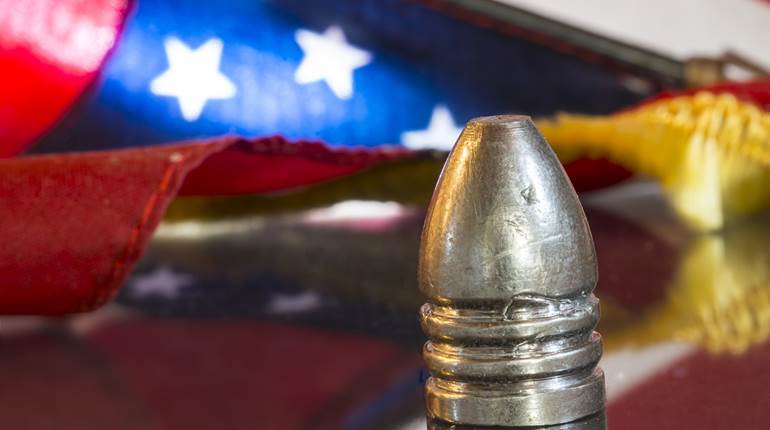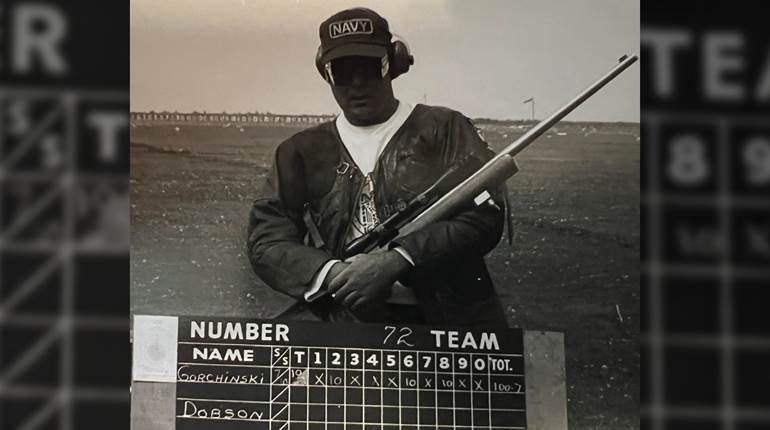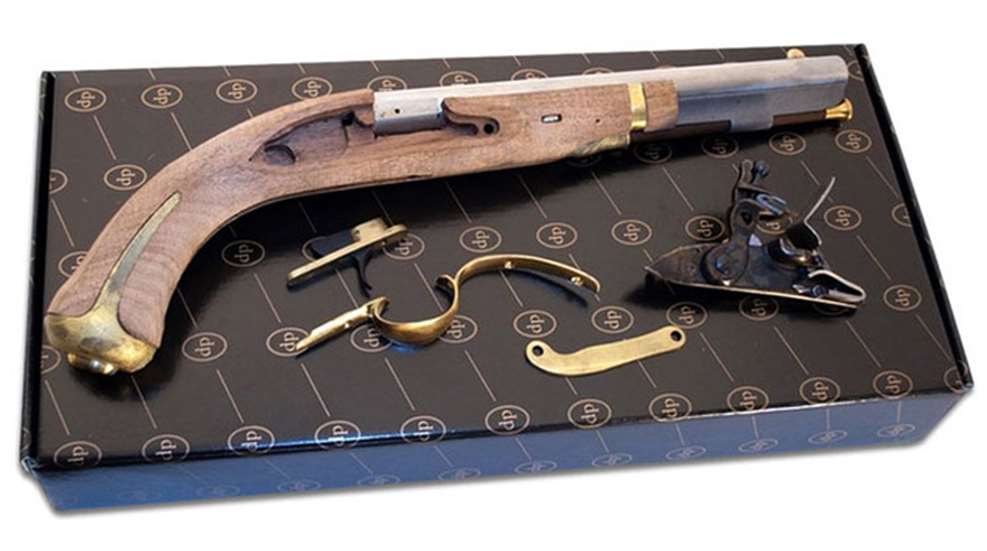
Today, we live in a golden age of firearm availability, particularly those with a historical bent to their interests. In the last few decades particularly, the United States has seen an influx of both high-quality reproductions of antique arms from centuries ago, with companies like Italian Firearms Group and Davide-Pedersoli leading the way with designs like their Harpers Ferry Model 1805 reproduction.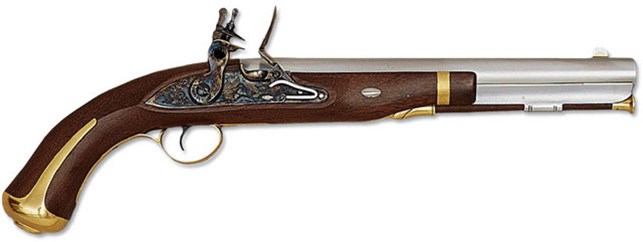
Davide-Pedersoli Model 1805 Harpers Ferry pistol (flintlock)
Defining the start of a “reproduction era,” if there even is one, is a difficult thing to do. For starters, how do you define a reproduction? For as long as guns have been around, people across the world have attempted to reproduce unfamiliar designs for their own use. This practice was made especially popular in the Khyber Pass region of Afghanistan, where British-made guns were copied, often poorly and with disastrous results, for use against invaders and in wars between domestic tribes. In the Eibar region of Spain, families with long histories of arms manufactory cranked out copies of popular guns of the era for export. Examples copied more often than not were the Colt 1908 Vest Pocket, the FN Baby Browning and numerous examples of Smith & Wesson revolvers.
However, when we discuss reproduction guns in the United States today, oftentimes we’re referring to modern, high-quality reproductions of antique arms, particularly those that are often too fragile or valuable to enjoy as shooters today. The Harpers Ferry Model 1805 undoubtedly falls squarely in that category.
Made between 1806 and 1808, the Model 1805 Harpers Ferry was the first military pistol produced by a national armory in the United States. More than 4,000 of the guns were produced in serial-numbered pairs reaching up to 2,048. The pistols were equipped with a round, smoothbore barrel measuring 10.0625 inches long, with a .54-caliber bore diameter that matched the similarly built Harpers Ferry Model 1803 rifle.
Harpers Ferry Model 1803 rifle
The barrel is set inside a slender half-stock, allowing the forward portion of the barrel to protrude beyond the end of the wood inlet. Strengthening this portion of the gun is a retaining rib that, on the originals, was soldered into place. This rib also provided a loop for retaining the ramrod, which was constructed originally from hickory. According to Charles Chapel in his book, U.S. Martial and Semi-Martial Single-Shot Pistols, the original hickory ramrods featured a brass tip at one end contoured to load a .54-caliber lead ball and a slotted end on the opposite side to accommodate a cleaning patch.
Original examples of these guns were produced with a so-called “armory-bright” finish, which left the barrel, lock and barrel rib with a gleaming, “white” finish. This finish was maintained by troops in the field by applying charcoal to the metal, keeping both muskets and pistols alike in armory-bright finish. This practice was a mainstay in military units before and during the production of the Model 1805 and continued in practice through the Civil War.
In keeping with the hand-built nature of these early guns, slight details vary throughout the more-than 4,000 Model 1805 Harpers Ferry pistols produced. Some surviving examples can be seen with a pronounced spherical shape on the butt-end of the gun, with the wood rising up in concert with the brass buttcap. On other examples of the gun, the wood slopes down gently to meet the outer edge of the brass cap, producing a rounded half-sphere rather than a fully spherical shape.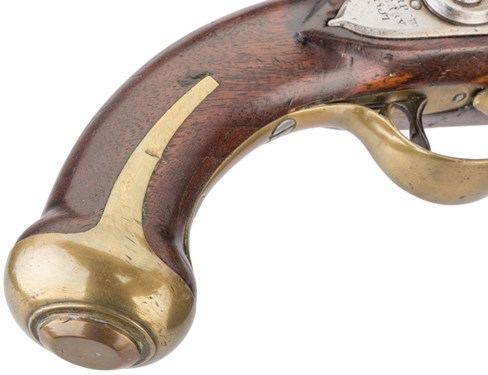
The former style is pictured above.
Fewer than 300 examples of these guns survive today, and in recent years, surviving examples have sold between $9,000-15,000 per gun, so the originals are far from attainable for the average shooter, and the surviving guns are certainly not range-worthy examples. With the expansion of the hobbyist firearm industry following WWII, many history enthusiasts found themselves looking for ways to experience the guns of the past. The National Muzzle Loading Rifle Association, founded in 1933, saw itself expanding, and the North-South Skirmish Association emerged in 1950 as a member organization of Civil War enthusiasts.
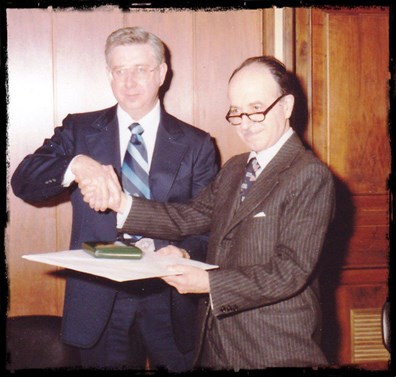 Stepping into this gap was Valmore Forgett, Jr., an enterprising firearm importer who saw an opportunity to feed a burgeoning market. In 1956, Forgett founded Navy Arms and began working with overseas manufacturers, first in Belgium then in Italy, to produce historical reproductions of antique arms, settling into partnerships with Davide-Pedersoli and Uberti.
Stepping into this gap was Valmore Forgett, Jr., an enterprising firearm importer who saw an opportunity to feed a burgeoning market. In 1956, Forgett founded Navy Arms and began working with overseas manufacturers, first in Belgium then in Italy, to produce historical reproductions of antique arms, settling into partnerships with Davide-Pedersoli and Uberti.
In an effort to produce desirable models for the U.S. market, historical accuracy gave way to market forces, and the design of Davide-Pedersoli’s modern-day Model 1805 Harpers Ferry pistol reflects those realities. Forgett, realizing that most of his consumers would be N-SSA guys shooting .58-caliber muskets eschewed the original .54-caliber smoothbore configuration of the Model 1805, opting instead for a .58-caliber, rifled pistol. Additionally, the armory-bright lock was treated with a color case-hardened finish to make it more attractive to buyers.
These specs were sent to the team at Davide-Pedersoli in the 1960s, and they began producing guns to Navy Arms’ specifications. Despite focusing heavily in recent years on producing historically accurate arms for the U.S. market, this early import never saw changes beyond the original specs, and the design continues to be imported in a .54-caliber rifled configuration with a color case-hardened lock.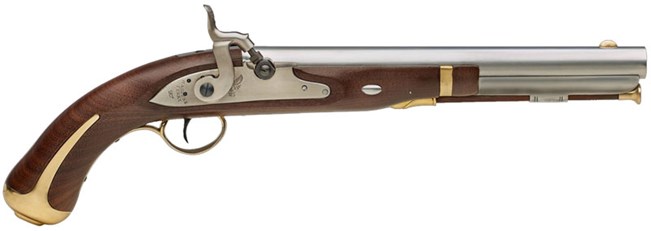
Davide-Pedersoli Model 1805 Harpers Ferry pistol (caplock)
However, recent years brought a middleman to the U.S. market in the form of Italian Firearms Group, providing consumers with a more-accessible importer that allows for a bit more flexibility in terms of finding reproductions and even fine-tuning the offerings available from Davide-Pedersoli. I spoke with Justin Dodd, chief of operations for Italian Firearms Group, at the 2018 NRA Show, and we discussed the ability of IFG to convey minimal changes to reproduction specs if the consumer wants it.
“So, could you make the Model 1805 with an armory-bright lock rather than a case-hardened one?” I inquired. The answer led to a wonderful, rainy-day project anyone can enjoy.
In addition to its finished pistol options, Davide-Pedersoli also provides a DIY kit for interested consumers at a reduced price. This kit comes with a fully assembled lock and a finished barrel, complete with a drilled vent hole. Where the work comes in is the barrel rib and brass components, all of which are fresh casts that require pretty serious final finishing. The wood stock comes inletted for most of these major components, though the final contours require some shaping on the part of the consumer.
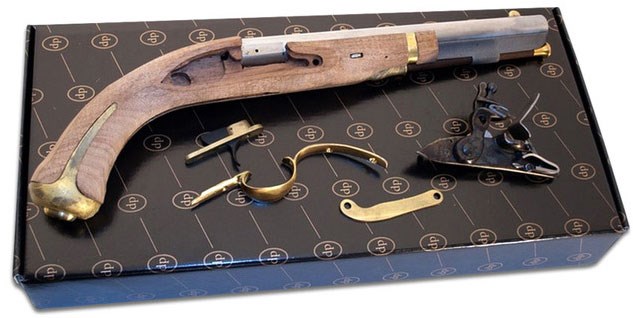
Parts included with the Davide-Pedersoli Model 1805 flintlock kit
For those who want to get to know their Model 1805 Harpers Ferry pistol and have a gun they can truly call their own, this kit offers a wonderful project that can be completed over a few solid weekends of work. Personally, I love putting together kits like these during the winter months, replacing range time with workshop time. We’ll go into the details of this build and show you what it takes to put together a Davide-Pedersoli Harpers Ferry Kit.
Additional Reading:
Model 1805 Harpers Ferry Pistol: Building the Davide-Pedersoli Kit
The Model 1805 Harpers Ferry Pistol: From Inception to Insignia
Arsenals and Armament: The Early Years of U.S. Martial Pistols













